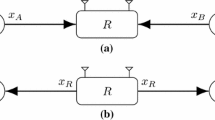Abstract
Orthogonal frequency division multiplexing based bidirectional relay network with several antennas at source nodes is the proposed system. To improve outage and bit error rate performance in presence of inphase/quadrature imbalance, concepts of maximal ratio combining and transmit antenna selection are applied at the source nodes in time slot I and time slot II respectively. Analysis of proposed bidirectional relay network with I/Q imbalance are modeled and briefly discussed. Through Monte-Carlo simulations, analytical results have been verified. Performance of proposed work is compared with the like literatures, and better performance is observed in the proposed work.





Similar content being viewed by others
Data availability
Data sharing not applicable to this article as no datasets were generated or analysed during the current study.
References
IQ Imbalance. (2008). RF imperfections in high-rate wireless systems: Impact and digital compensation (pp. 139–183). Dordrecht: Springer Netherlands.
Pan, L., Li, Z., Wang, Z., & Zhang, F. (2019). Joint relay selection and power allocation for the physical layer security of two-way cooperative relaying networks. Wireless Communications and Mobile Computing, 1839256.
Liao, K., Zhao, S., Long, Y., Huang, G., & Tang, D. (2019). Distributed beamforming design for nonregenerative two-way relay networks with simultaneous wireless information and power transfer. Wireless Communications and Mobile Computing, 3519468.
Zhan, Q., Member, S., Minn, H., Adc, D. A. C., & Iming, I. Q. T. (2016). A solution to timing mismatches between the in-phase and quadrature branches of millimeter-wave transmitter and receiver. IEEE Globecom Workshops (GC Wkshps), 1(1), 1–6. https://doi.org/10.1109/GLOCOMW.2016.7848826
Narasimhan, B., Wang, D., Narayanan, S., Minn, H., & Al-Dhahir, N. (2009). Digital compensation of frequency-dependent joint Tx/Rx I/Q imbalance in OFDM systems under high mobility. IEEE Journal of Selected Topics in Signal Processing, 3(3), 405–417. https://doi.org/10.1109/JSTSP.2009.2020325
Julus, L. J., Manimegalai, D., & Chakkaravarthy, S. S. (2019). FBMC-based dispersion compensation using artificial neural network equalization for long reach-passive optical network. International Journal of Wavelets, Multiresolution and Information Processing. https://doi.org/10.1142/S021969131941011X
Qi, J., Aissa, S., & Alouini, M. (2012). Analysis and compensation of I/Q imbalance in amplify-and-forward cooperative systems. In 2012 IEEE wireless communications and networking conference (WCNC) (pp. 215–220). doi:https://doi.org/10.1109/WCNC.2012.6214150
Roobert, A. A., & Rani, D. G. N. (2019). A survey on parameter optimization of mobile communication band LNA design. International Journal of RF and Microwave Computer-Aided Engineering. https://doi.org/10.1002/mmce.21720
Kumaran, V. N. S., Rajkumar, S., Suresh, M. N., & Thiruvengadam, S. J. (2014). Outage analysis of PLNC based bidirectional relay network in the presence of I/Q imbalance. International Journal of Engineering and Technology, 6(4), 1758–1767.
González, G. J., Gregorio, F. H., Cousseau, J. E., Riihonen, T., & Wichman, R. (2017). Full-duplex amplify-and-forward relays with optimized transmission power under imperfect transceiver electronics. EURASIP Journal on Wireless Communications and Networking. https://doi.org/10.1186/s13638-017-0863-x
Rabiei, P., Namgoong, W., & Al-dhahir, N. (2009). Reduced-complexity joint baseband compensation of phase noise and I/Q imbalance for MIMO-OFDM. In IEEE globecom.
Ravindran Unnithan Jalaja, R., Periakarupan Gurusamy Sivabalan, V., & Sundarrajan Jayaraman, T. (2019). Energy efficient bidirectional relay network with spatial modulation. International Journal of Communication Systems. https://doi.org/10.1002/dac.4187
Rajakumar, G., & Roobert, A. A. (2018). Design of low power VLSI architecture of line coding schemes. Wireless Personal Communications, 99(4), 1455–1473.
Kumar, G. R., & Andrew Roobert, A. (2017). Low power VLSI schematic design of PC/BPSC generation and degeneration. Asian Journal of Research in Social Sciences and Humanities, 7(2), 160–164.
Rajakumar, G., & Andrew Roobert, A. (2016). Area and power optimized hardware design of bi-phase space coding/phase coding technique for wireless sensor applications". Asian Journal of Information Technology, 15(19), 3657–3663.
Roobert, A. A., Praghash, K., Rajavel, S. E., & Bridjith, A. A. (2018). Design and analysis of demultiplexer based CPG for high speed shifting memory. In Intelligent computing and control systems (ICICCS).
Bai, R., & Hranilovic, S. (2020). Absolute value layered ACO-OFDM for intensity-modulated optical wireless channels. IEEE Transactions on Communications, 68(11), 7098–7110.
Tusha, A., Doğan, S., & Arslan, H. (2020). A hybrid downlink NOMA with OFDM and OFDM-IM for beyond 5G wireless networks. IEEE Signal Processing Letters, 27, 491–495.
Jaradat, A. M., Hamamreh, J. M., & Arslan, H. (2020). OFDM with hybrid number and index modulation. IEEE Access, 8, 55042–55053.
Kim, H., Park, Y., Kim, J., & Hong, D. (2020). A low-complex SVD-based F-OFDM. IEEE Transactions on Wireless Communications, 19(2), 1373–1385.
Werbunat, D., Meinecke, B., Schweizer, B., Hasch, J., & Waldschmidt, C. (2021). OFDM-based radar network providing phase coherent DOA estimation. IEEE Transactions on Microwave Theory and Techniques, 69(1), 325–336.
Author information
Authors and Affiliations
Corresponding author
Ethics declarations
Conflict of interest
On behalf of all authors, the corresponding author states that there is no conflict of interest.
Additional information
Publisher's Note
Springer Nature remains neutral with regard to jurisdictional claims in published maps and institutional affiliations.
Rights and permissions
About this article
Cite this article
Senthil Kumaran, V.N., Thiruvengadam, S.J. Analysis of Bidirectional Relay Network Based on OFDM System in Presence of Inphase/Quadrature imbalance. Wireless Pers Commun 123, 2151–2169 (2022). https://doi.org/10.1007/s11277-021-09232-2
Accepted:
Published:
Issue Date:
DOI: https://doi.org/10.1007/s11277-021-09232-2




